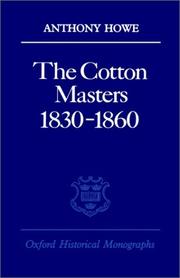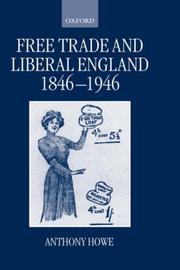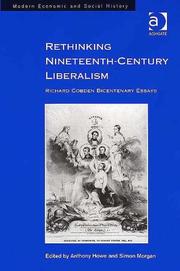| Listing 1 - 8 of 8 |
Sort by
|

ISBN: 019821894X Year: 1984 Publisher: Oxford Clarendon
Abstract | Keywords | Export | Availability | Bookmark
 Loading...
Loading...Choose an application
- Reference Manager
- EndNote
- RefWorks (Direct export to RefWorks)
Cotton textile industry --- Tissus de coton --- History --- Industrie --- Histoire --- -Textile industry --- Lancashire (England) --- -History --- Textile industry --- History.

ISBN: 019820146X 9780198201465 Year: 1997 Publisher: Oxford,
Abstract | Keywords | Export | Availability | Bookmark
 Loading...
Loading...Choose an application
- Reference Manager
- EndNote
- RefWorks (Direct export to RefWorks)
Book
Year: 1997 Publisher: New York ; Oxford ; Athens Oxford University Press
Abstract | Keywords | Export | Availability | Bookmark
 Loading...
Loading...Choose an application
- Reference Manager
- EndNote
- RefWorks (Direct export to RefWorks)

ISBN: 9780754655725 0754655725 9781315244297 9781351903608 9781138259348 Year: 2006 Publisher: Aldershot Ashgate
Abstract | Keywords | Export | Availability | Bookmark
 Loading...
Loading...Choose an application
- Reference Manager
- EndNote
- RefWorks (Direct export to RefWorks)
Liberalism --- Social reformers --- Libéralisme --- Réformateurs sociaux --- History. --- Biography. --- Histoire --- Biographie --- Cobden, Richard, --- Influence. --- Great Britain --- Grande-Bretagne --- Politics and government --- Politique et gouvernement --- Libéralisme --- Réformateurs sociaux --- Liberal egalitarianism --- Liberty --- Political science --- Social sciences --- History --- Biography --- Manchester manufacturer,
Book
ISBN: 3030293106 9783030293109 3030293092 Year: 2020 Publisher: Cham : Springer International Publishing : Imprint: Palgrave Macmillan,
Abstract | Keywords | Export | Availability | Bookmark
 Loading...
Loading...Choose an application
- Reference Manager
- EndNote
- RefWorks (Direct export to RefWorks)
Romanticism and the Letter is a collection of essays that explore various aspects of letter writing in the Romantic period of British Literature. Although the correspondence of the Romantics constitutes a major literary achievement in its own right, it has received relatively little critical attention. Essays focus on the letters of major poets, including Wordsworth, Byron, Shelley and Keats; novelists and prose writers, including Jane Austen, Leigh Hunt and Charles Lamb; and lesser-known writers such as Melesina Trench and Mary Leadbeater. Moving from theories of letter writing, through the period’s diverse epistolary culture, to essays on individual writers, the collection opens new perspectives for students and scholars of the Romantic period. Madeleine Callaghan is Senior Lecturer in Romantic Literature at the University of Sheffield. Liverpool University Press published her first monograph, Shelley’s Living Artistry: The Poetry and Drama of Percy Bysshe Shelley, in 2017, and her book, The Poet-Hero in the Work of Byron and Shelley (2019) is published by Anthem Press. Anthony Howe is Reader in English Literature at Birmingham City University. His publications include Byron and the Forms of Thought (Liverpool, 2013) and The Oxford Handbook of Percy Bysshe Shelley (2013), edited with Michael O’Neill. He is currently writing a monograph about literary letter writing in the British Romantic period.
Digital
ISBN: 9783030293109 Year: 2020 Publisher: Cham Springer International Publishing :Imprint: Palgrave Macmillan
Abstract | Keywords | Export | Availability | Bookmark
 Loading...
Loading...Choose an application
- Reference Manager
- EndNote
- RefWorks (Direct export to RefWorks)
Romanticism and the Letter is a collection of essays that explore various aspects of letter writing in the Romantic period of British Literature. Although the correspondence of the Romantics constitutes a major literary achievement in its own right, it has received relatively little critical attention. Essays focus on the letters of major poets, including Wordsworth, Byron, Shelley and Keats; novelists and prose writers, including Jane Austen, Leigh Hunt and Charles Lamb; and lesser-known writers such as Melesina Trench and Mary Leadbeater. Moving from theories of letter writing, through the period’s diverse epistolary culture, to essays on individual writers, the collection opens new perspectives for students and scholars of the Romantic period. Madeleine Callaghan is Senior Lecturer in Romantic Literature at the University of Sheffield. Liverpool University Press published her first monograph, Shelley’s Living Artistry: The Poetry and Drama of Percy Bysshe Shelley, in 2017, and her book, The Poet-Hero in the Work of Byron and Shelley (2019) is published by Anthem Press. Anthony Howe is Reader in English Literature at Birmingham City University. His publications include Byron and the Forms of Thought (Liverpool, 2013) and The Oxford Handbook of Percy Bysshe Shelley (2013), edited with Michael O’Neill. He is currently writing a monograph about literary letter writing in the British Romantic period.
Literature --- literatuur --- anno 1700-1799 --- anno 1800-1899
Book
ISBN: 9783030293109 Year: 2020 Publisher: Cham Springer International Publishing :Imprint: Palgrave Macmillan
Abstract | Keywords | Export | Availability | Bookmark
 Loading...
Loading...Choose an application
- Reference Manager
- EndNote
- RefWorks (Direct export to RefWorks)
Literature --- literatuur --- anno 1700-1799 --- anno 1800-1899
Digital
ISBN: 9781781380918 9781781385555 Year: 2013 Publisher: Liverpool Liverpool University Press
Abstract | Keywords | Export | Availability | Bookmark
 Loading...
Loading...Choose an application
- Reference Manager
- EndNote
- RefWorks (Direct export to RefWorks)
Byron and the Forms of Thought is a major new study of Byron as a poet and thinker. While informed by recent work on Byron’s philosophical contexts, the book questions attempts to describe Byron as a philosopher of a particular kind. It approaches Byron, rather, as a writer fascinated by the different ways of thinking philosophy and poetry are taken to represent. After an Introduction that explores Byron’s reception as a thinker, the book moves to a new reading of Byron’s scepticism, arguing for a close proximity, in Byron’s thought, between epistemology and poetics. This is explored through readings of Byron’s efforts both as a philosophical poet and writer of critical prose. The conclusions reached form the basis of an extended reading of Don Juan as a critical narrative that investigates connections between visionary and political consciousness. What emerges is a deeply thoughtful poet intrigued and exercised by the possibilities of literary form.
| Listing 1 - 8 of 8 |
Sort by
|

 Search
Search Feedback
Feedback About UniCat
About UniCat  Help
Help News
News